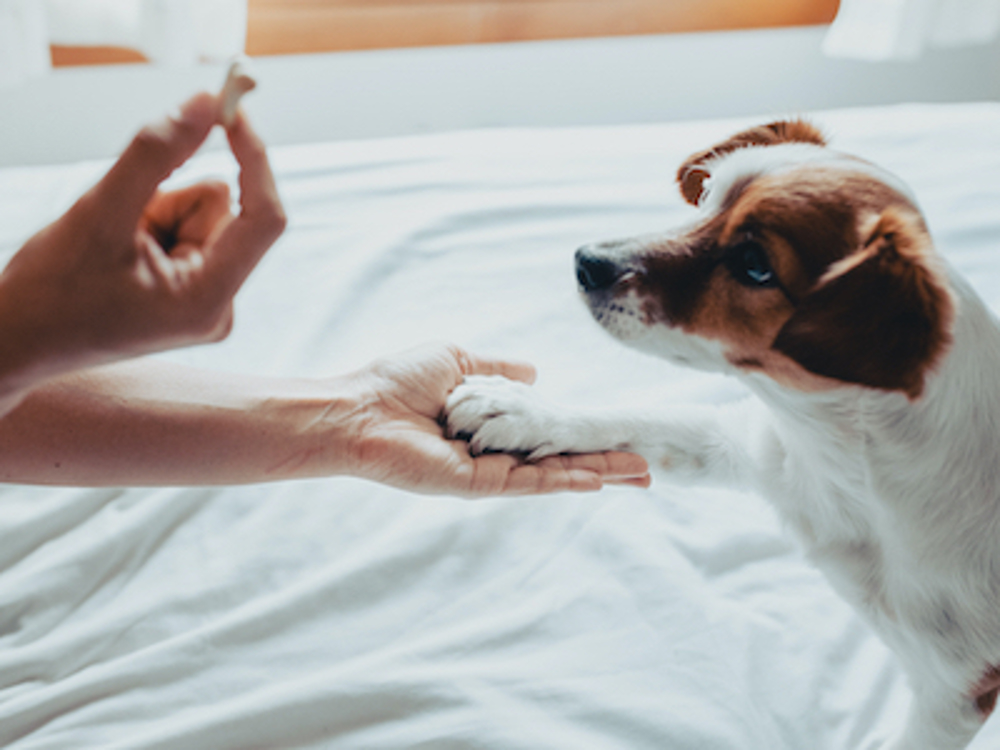Training your dog at home

Home is the best place for training your dog – the distractions are controllable, the atmosphere can remain calm and you can choose your time. Your dog should also be relaxed, as they are in their environment.
5 tips for training your dog at home
1. Prepare well
- What do you want to teach your dog? Maybe it is stopping your dog from jumping up, getting them to walk on a loose lead, or coming back when they are called. Even though these things seem like outdoor activities, it's best to focus on the basics as well as you can while you are indoors, and then once you have a great foundation to build on, you can venture out into the garden. Make a list of your aims
- Look on our website for training ideas or explore other sites on the internet. Whatever you find, make sure that the instructor is using kind, motivational methods and positive reinforcement only, e.g. toys, food, verbal and hands-on praise, as opposed to shouting, lead jerks, or any form of physical punishment
- Prepare your training equipment, e.g. lead or harness. You will need a good supply of rewards for your dog, including high-value treats – those treats they love and can’t refuse – and toys used specifically for training purposes
- Chose a quiet room with minimal distractions. Maybe ask a member of your family to film you on your mobile phone, or set up your phone to record if you can, so you can play back what you do
- Keep your treats away from you or whoever is training – e.g. in a pot on the side – so your dog can see what’s on offer and you can reward, rather than a bribe, when you start your training
- Prepare yourself – get in the right frame of mind, be controlled yet calm and motivational
- Prepare your dog – get out your treats or have a game with their favorite toy to make sure they are engaged with you.
"Fix Any Bad Dog Behavior in Minutes With The Most Powerful Dog Training Technique Ever"
2. Teach thoroughly
- Break things down into tiny components, one lesson at a time – rewarding each component or even a fraction of component if you can, ending in a chain of events
- Do not try to rush or shortcut
- Teach each component until the dog gets the idea
- Link the components together, backward if you can (starting with the end part first)
- Video yourself and your dog so you or your instructor can analyze them later. It’s good practice – looking back at what you have done helps you to become a better dog trainer
- Repeat the components and chain, giving the dog help and lots of encouragement along the way
- Add cues (commands or signals) once your dog has the idea of what you are doing, and you can reasonably predict they will do it
3. Generalise your teaching
- Take your dog into a different room or the garden and do the component training again and then build up the chains. This way your dog will start to learn that it doesn’t matter where you are, the exercise is still the same
- Change to other rooms until you have run out of options
4. Proof your training
- You will have started the proofing process, testing whether your dog still understands what you have taught them by changing rooms and carrying out the exercise somewhere different. This will have added distractions. Now go back to the first training area and add a small distraction (e.g. a toy, a person, the cat)
- Go back to the basic level of training again to help your dog get it right and make sure your dog understands that, even if there is a distraction, they should still do as they are asked and it will be worth their while. Give treats or a favorite toy for good behavior.
- If your dog makes mistakes, think about what you can do to help them get it right next time. Maybe make it a bit easier, move distractions a bit further away, and work on the 'leave' command first, so that your dog understands they should remain focused on you, and not take the distraction
"Fix Any Bad Dog Behavior in Minutes With The Most Powerful Dog Training Technique Ever"
5. Keep it fun
- Make sure you are keeping yourself upbeat – think of the best, most motivational teacher you ever had – that’s who you need to be to your dog!
- If you are feeling unwell, tired, or impatient, it's best to leave training until you feel better
- Teach some fun stuff – even just tricks will help you to build a relationship with your dog. Be the human your dog wants you to be!
"Fix Any Bad Dog Behavior in Minutes With The Most Powerful Dog Training Technique Ever"

